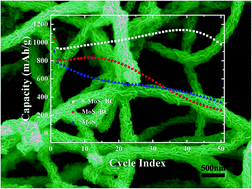A facile synthesis method and electrochemical studies of a hierarchical structured MoS2/C-nanocomposite†
Abstract
A uniformly coated MoS2/carbon-nanocomposite with a three-dimensional hierarchical architecture based on carbonized bacterial cellulose (CBC) nanofibers is synthesized by a facile one-step hydrothermal method followed by thermal annealing at 700 °C in an Ar atmosphere. Strong hydrogen bonds between the Mo precursor and the BC nanofibers are found to be crucial for the in situ growth of MoS2 nanosheets on the nanofibers during the hydrothermal process. The fibrous structure was maintained and the connection between MoS2 and the nanofibers were strengthened in the sintering process, leading to an improved stability of the resulting nanocomposite upon electrochemical cycling. The low-cost and environmentally friendly 3D web-like structure enables binder-free and carbon-free electrodes for lithium-ion batteries, which exhibit high specific discharge capacities up to 1140 mA h g−1 at the C-rate of 1C without significant capacity fading for over 50 cycles. The porous conductive hierarchical structure of the composite endows excellent rate performance by avoiding the aggregation of the MoS2 nanosheets and by accommodating mechanical stress which appears upon electrochemical cycling.


 Please wait while we load your content...
Please wait while we load your content...